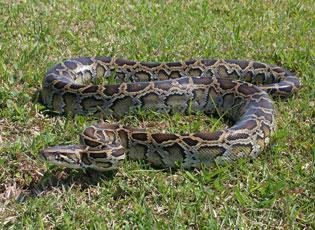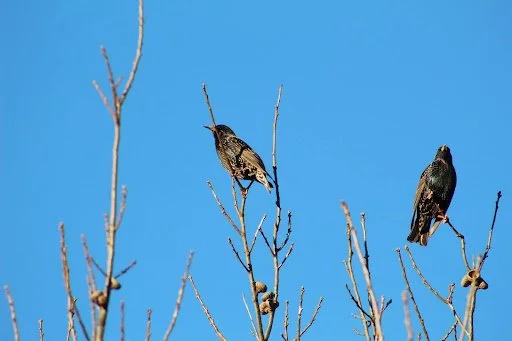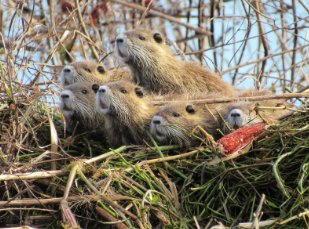A Brief Introduction to the Invasive Species Crisis in North Carolina
Burmese pythons are a well-known invasive species in Florida. While many of North Carolina’s invasive species are less eye-catching, they are no less harmful. Source: National Invasive Species Information Center
10 foot pythons. Giant African snails. Lizards the size of cats. In Florida, the invasive species crisis takes center stage: the invasive animals are large, often threatening, and visibly foreign.
According to Dr. Johnny Randall, retired Director of Conservation at the North Carolina Botanical Garden, many North Carolinians don’t even know invasive species when they see them.
“I think that a lot of people just you know, especially with invasive plants, they grow up with these around them, and they think that they're just part of the natural ecosystem,” Dr. Randall said.
This makes it much more difficult to manage populations of invasive plants. When the average person doesn’t know that a species is invasive, how can they begin to help identify or destroy it?
Photo by Charlie Innis via the Fig Buttercup Project.
The fig buttercup, for example, is a low-growing plant with heart-shaped leaves. In March and April, this plant develops attractive bright yellow flowers that create quite the pretty picture along North Carolina’s streams and floodplain ecosystems.
Don’t let the flowers fool you, though. Fig buttercup is incredibly harmful to the stream sides it inhabits, creating a dense mat of leaves that crowd out other native plants that are more beneficial to pollinators and herbivores.
“There are no insects that eat the leaves,” Dr. Randall said. “So it's not a food supply for anything. I have seen bees on the flowers, but I don't know how useful its pollen or nectar is for them.”
“The point is that it is one thing that is flowering at one time in a floodplain, whereas in a naturally occurring floodplain like that with a dozen spring ephemerals there are a lot of different kinds of pollen and nectar available for the pollinators.”
In his work as the former Director of Conservation at the North Carolina Botanical Garden, Dr. Randall worked directly with fig buttercups and other invasive plant species. Volunteers known as “Green Dragons” work every day of the week to manage the garden’s conservation areas. They often work to remove invasive species like fig buttercup through mechanical means such as pulling. Conservation staff also use herbicides to protect the area from invasive plant growth.
In addition to plants that were introduced accidentally or for ornamental purposes, North Carolina is now “home” to a number of invasive insects, birds, and mammals.
The emerald ash borer, for example, has killed tens of millions of ash trees across the eastern and midwestern United States, fundamentally changing the landscape in these regions. More recently, the infamous spotted lanternfly has also made an appearance. This species is a threat to wild maples, oaks, willows, walnuts, and many cultivated fruit species like apples and stone fruits.
Male and female house finch, respectively. Photo by author.
Many birds commonly seen on campus at UNC are also invasive. Both house finches and house sparrows were introduced to North Carolina, although the house finch is native to western North America. As their names suggest, both species like to live in and around man-made structures. House finches are carriers for diseases that can impact native purple and goldfinches and tend to compete with them for nesting space. European house sparrows are known to harass, injure, or kill native birds for nesting space.
European starlings on campus. Photo by author.
European starlings were introduced by Shakespeare enthusiasts in New York’s Central Park in an effort to introduce every bird referenced by the author to the United States (yikes). Despite their flashy looks and varied vocalizations, they are a menace to native birds, known to eject the eggs of fellow cavity-nesters and steal their nests. Their large flocks also compete for food sources, and European starlings are known to cause millions of dollars in damage to grain and fruit crops.
A nest of juvenile nutria. Photo by Chris Turner via the North Carolina Wildlife Resources Commission.
While invasive mammals and reptiles are somewhat less of a problem in the Piedmont (with the exclusion of feral cats), North Carolina is home to a handful of them. The mountains boast a small population of feral hogs, and South American nutria have colonized parts of the coast.
And those giant reptiles from Florida? They could be coming, too. With climate change increasing the habitable range of many tropical species northward, invasive species with footholds in the Deep South are likely to migrate towards North Carolina.
“Pythons will be here sooner or later,” Dr. Randall said.
With the state’s role in the management of invasive species, management is very much a political issue, according to Dr. Randall. North Carolina’s Noxious Weeds List, for example, is managed by the North Carolina Department of Agriculture and Consumer Services. This, according to Dr. Randall, leaves the issue at the mercy of the agricultural and horticultural industries.
“In order for a plant to get on the noxious weed list, it has to be approved by some agriculture board. Which is mostly controlled by the horticulture and agriculture industry. So if a plant has some economic benefit to the nursery industry, then there's no way it's going to get on the noxious weed list,” Dr. Randall said.
The state only directly enforces controls on plants that are on its noxious weeds list, so avoiding sanctions against plants that are commonly used for ornamental purposes or hold economic benefits places the Department of Agriculture in a conflict of interest regarding the protection of native plants and ecosystems.
What You Can Do
The best thing you can do to prevent the spread of invasive plants is to make sure you’re not planting them yourself. It’s best to plant native whenever possible, but at the very least avoid the 41 worst offenders on the North Carolina Invasive Species Council’s “Shun List.” These plants are not on the state’s Noxious Weeds List and are still sold in North Carolina but spread aggressively and pose a significant threat to native ecosystems.
Planting native species in your own yard can also be a great benefit for local wildlife. Native pollinators like butterflies have co-evolved with native plants and rely on them for food and shelter. Often, these insects cannot feed on non-native plants. As a result, both native insects and the birds that rely on them have been in decline in recent years.
“Even a seed-eating bird like a cardinal feeds its young caterpillars,” Dr. Randall said. “... Many of our perching birds. The ones that, you know, we're most familiar with in our backyards. They're really in decline–in steep decline. And there are a lot of different factors, but that's probably one of them, is that there's not enough food for them to raise their young.”
Once you do some research and learn to identify invasive species in your area, you can also report sightings via iNaturalist. iNaturalist is a citizen scientist website used by biologists and hobbyists alike to report plant and wildlife sightings. Many projects tracking the spread of invasive species use iNaturalist sightings to bolster their data.
Finally, consider volunteering with parks like the North Carolina Botanical Garden to directly help limit the damage done by invasive species. When populations in an area are still small, individual efforts can make a big difference!





